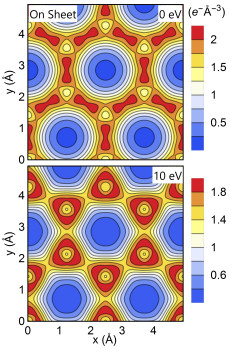Warm Dense Crystallography: Digging Deeper into WDM
DFT Calculations Run at NERSC Confirm Free-Electron Laser Experiments
May 23, 2016
By Kathy Kincade
Contact: cscomms@lbl.gov

Finite temperature charge reorganization in graphene sheets. Image: Ryan Valenza. University of Washington
Researchers from the University of Washington are using supercomputers at Department of Energy’s National Energy Research Scientific Computing Center (NERSC) and data from X-ray free-electron laser (XFEL) experiments to gain new insights into warm dense matter (WDM), one of the most challenging aspects of contemporary plasma physics.
While WDM is believed to be at the core of very large planets and to exist as a challenging transient state during the inertial confinement fusion process, in terms of our scientific understanding of exactly what it is it remains a rather large “gray area” between solid matter and plasma.
“WDM is in that funky regime that is too hot to be condensed solid matter and too cold to be plasma,” explained Ryan Valenza, a third-year graduate student at the University of Washington and lead author on a new paper in Physical Review B that demonstrates the role XFELs can play in broadening our understanding of WDM. “It is an intermediate regime that is not well understood because the electronic behavior is intermediate between being fully quantum-mechanical and fully classical-mechanical.”
XFELs—the first light sources that can routinely generate coherent, ultra-brilliant, tunable laser pulses in the X-ray regime—are having a broad impact across many areas of science, including physics, chemistry, biology and materials science. Early XFEL research primarily addressed atomic and small-cluster physics, but more recent studies are looking at how extreme X-ray exposure affects the properties of condensed phases of matter.
Four Crystalline Reference Materials
For example, while several research groups have focused on using existing dense plasma physics theories and codes to try and explain WDM and its properties, the results of several XFEL experiment conducted at the Stanford Linear Accelerator caused Valenza and co-author Gerald Seidler, professor of physics at the University of Washington, to question the viability of this approach for the special case of perfect crystals being heated into the WDM regime by the XFEL pulse itself.
Valenza and Seidler used density functional theory (DFT)—where the primary quantity of interest is the electron charge density—to model four diverse reference materials: crystalline lithium fluoride, graphite, diamond and beryllium. They chose these materials, Valenza said, to have materials that span a wide range of different ambient properties: a metal, ionic insulator, covalent insulator and semi-metal. The calculations were done using a frozen lattice because when samples are heated by the ultrafast XFEL pulse the crystalline structure is still intact but the electronic structure is heavily excited—thus bridging the gap between condensed matter physics, which has perfect crystals, and plasma, where heavily energized ions are moving around.
The DFT calculations, which used VASP and different electronic structure models to calculate the charge density of the four crystalline systems, were initially run on NERSC’s Hopper system and then Edison after Hopper was decommissioned in late 2015. After exciting the crystals to temperatures within the WDM regime, Valenza compared the calculations to the findings from the earlier XFEL X-ray diffraction experiments.
“I ran calculations on WDM systems using both condensed matter code and plasma code to model X-ray diffraction patterns; then, I compared the two and got two very different results,” Valenza explained. “What this means is that a fuller, quantum-mechanical treatment is necessary to understand WDM.” It also demonstrates that X-ray diffraction is very sensitive to the complexity of the electronic structure model that is applied and that X-ray diffraction experiments can be used to test the validity of these models.
This is the first time researchers have used the combination of DFT and X-ray diffraction to study crystalline WDM, and the findings have much broader implications, he added.
“One of the key things we were trying to do was demonstrate that X-ray diffraction is one of the most important diagnostics for WDM because it is a direct probe of real space-charged density, which is also the basic quantity of interest in density functional theories,” Valenza said.
For example, he is now using this same approach to small molecule crystallography with an eye toward understanding phenomenon that could be relevant for protein studies.
“Our results suggest important consequences for macromolecular crystallography studied at XFELs, where the long-term technical and scientific goal is to determine the structure of proteins and biological macromolecules at atomic resolution,” he concluded.
About NERSC and Berkeley Lab
The National Energy Research Scientific Computing Center (NERSC) is a U.S. Department of Energy Office of Science User Facility that serves as the primary high performance computing center for scientific research sponsored by the Office of Science. Located at Lawrence Berkeley National Laboratory, NERSC serves almost 10,000 scientists at national laboratories and universities researching a wide range of problems in climate, fusion energy, materials science, physics, chemistry, computational biology, and other disciplines. Berkeley Lab is a DOE national laboratory located in Berkeley, California. It conducts unclassified scientific research and is managed by the University of California for the U.S. Department of Energy. »Learn more about computing sciences at Berkeley Lab.







